LOW-COST MEDICAL INSTRUMENTATION FOR DEVELOPING COUNTRIES
Development of Instrumentation for Eye diseases diagnosis
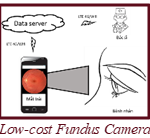 |
The most important organs among five human senses are eyes, which are responsible for 80% of all impressions we perceive. Retina plays a vital role in eyes’ functionality. Damage to retina can lead to permanent blindness. Research goal: Developing low-cost fundus cameras (both smartphone-based and table-top) and low-cost OCT/OCTA systems |
Development of Low-cost systems for Sleep apnea diagnosis
 |
Sleep apnea is a potentially serious sleep disorder in which breathing repeatedly stops and starts. If you snore loudly and feel tired even after a full night’s sleep, you might have sleep apnea. The main types of sleep apnea are: (1) Obstructive sleep apnea (throat muscles relax related), (2) Central sleep apnea (brain-related), and (3) Complex sleep apnea syndrome (both obstructive sleep apnea and central sleep apnea) Research goal: Developing low-cost polysomnography systems. |
Development of wearable devices for health monitoring & CVD diagnosis
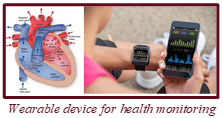 |
Wearable devices are smart electronic devices with micro-controllers that can be incorporated into clothing or worn on the body as implants or accessories. Apart from commercial uses, wearable technology is being incorporated into navigation systems, advanced textiles, and healthcare. Research goal: Developing wearable devices such as ECG holters, cuff-less blood pressure monitors for health monitoring and cardiovascular diseases (CVD) diagnosis. |
BIOMEDICAL PHOTONIC LAB IN INSTRUMENTATION APPLICATION
| Utilizing the characterization of LED, LASER, optical sensors, optical components… in Ultraviolet, Visible light, Infrared light to design and make medical devices or apply them to solve the medical problems in diagnosis or therapy. | 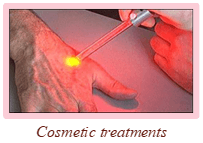 |
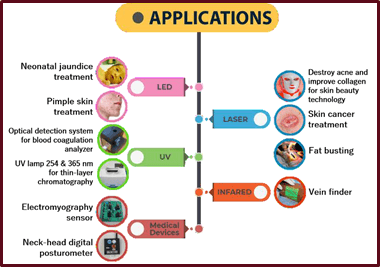
LAB ON A CHIP (LOC)
| Exploiting unique and novel physical and/or chemical characteristics of metallic nanoparticles, we focus on the design of plasmonic biosensors and nanoparticle-based colorimetric biosensors for early detection of pathogens, cancers and nervous system diseases with improved analytical characteristics. We also exploit the remarkable properties of metallic nanostructures for near patient testing platforms, lab-on-a-chip sensors and incorporate these biosensing platform into smartphones or similar portable electronic devices for mobile sensing. | 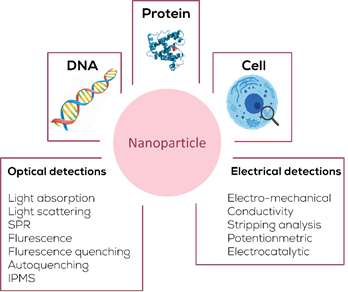 |
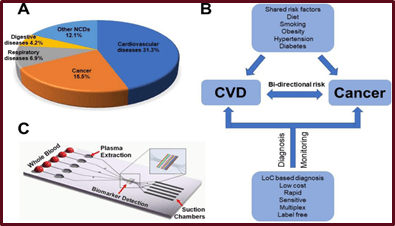 |
Lab-on-a-chip (LoC) platforms for cardiovascular disease (CVD) and cancer biomarkers detection. (A) CVD and cancer are leading causes of death worldwide according to WHO (the pie chart only shows noncommunicable diseases (NCDs)); (B) Shared risk factors between CVD and cancer and LoC platform can improve disease diagnosis and monitoring; (C) An example of LoC-based protein biomarker detection from blood |
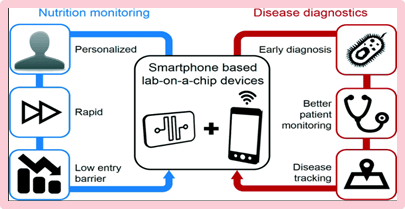 |
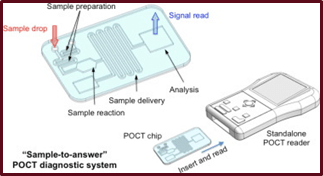 |
| Smartphone based LOC technology could provide a number of important advantages for health monitoring and diagnostics. Key benefits for nutrition monitoring include personalized and rapid care with a low barrier to entry while for disease diagnostics it offers early diagnosis, better patient monitoring, and spatiotemporal tracking capability. | |
| Website: https://bme.hcmiu.edu.vn Tel: (84-8)-37 24 42 70 – Ext: 3236 |
Dr. Ngô Thanh Hoàn Contact: nthoan@hcmiu.edu.vn |
Dr. Phạm Thị Thu Hiền Contact: ptthien@hcmiu.edu.vn |
Dr. Huỳnh Chấn Khôn Contact: hckhon@hcmiu.edu.vn |
